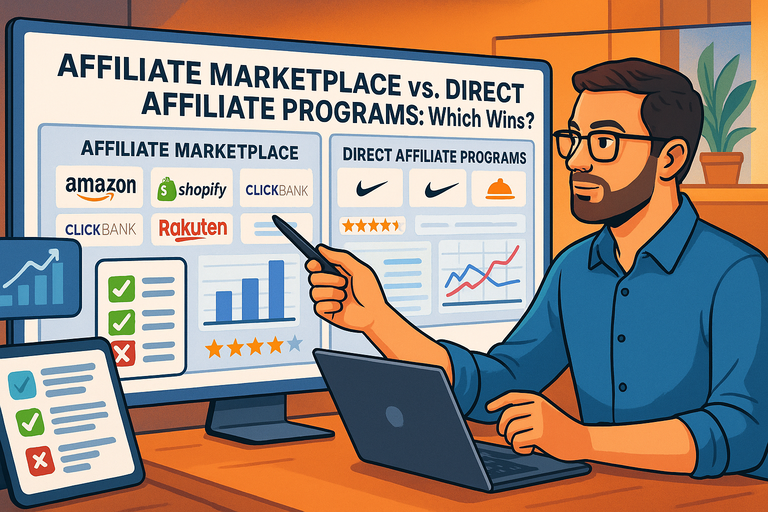Table of Contents
If you’re stepping into affiliate marketing, one of the first choices you’ll face is whether to join an affiliate marketplace or work directly with affiliate programs. Both can help you earn commissions by promoting products, but they work differently—and those differences can make or break your income potential.
In this guide, I’ll walk you through how affiliate marketplaces compare to direct affiliate programs, what makes each one shine (or stumble), and how to decide which fits your business goals best.
What Is an Affiliate Marketplace?
An affiliate marketplace is a centralized platform where brands and affiliates connect. Instead of signing up for each brand separately, you can find hundreds—or even thousands—of programs in one place.
Think of it like an online mall for affiliate marketers: each “store” is a merchant with its own offers, commission rates, and promotional tools.
How Affiliate Marketplaces Work in Practice
When you log into a marketplace like Awin, CJ Affiliate, or ClickBank, you can browse available offers by category—fashion, tech, SaaS, travel, and more. Once you’re approved by a brand, you can start promoting their links right away.
For example: From the Awin dashboard, click Merchants > Search for Merchants > Filter by Category. Then apply to any brand that fits your niche.
Key perks include:
- Centralized management: One dashboard for multiple programs.
- Automatic payments: The marketplace tracks and processes all commissions.
- Diverse options: You can diversify your income streams by promoting products from different industries.
It’s perfect for beginners who want convenience or experienced marketers looking to scale quickly without administrative headaches.
What Are Direct Affiliate Programs?
Direct affiliate programs are partnerships you build directly with individual brands—no middleman involved.
You sign up through the company’s own website (for example, Shopify Affiliate Program or Bluehost Affiliate Program) and work exclusively with their internal affiliate system.
Why Brands Run Their Own Affiliate Programs
Many companies run their own programs because they want more control—over branding, communication, and commission rules.
Here’s what that means for you:
- Higher potential payouts: Without a marketplace fee, brands can afford to pay higher commissions.
- Closer brand relationship: You often get direct access to affiliate managers, insider promos, and first dibs on new products.
- Custom tracking systems: Brands may use proprietary dashboards (e.g., Refersion, PartnerStack) that give more detailed insights.
However, you’ll need to manage separate logins, payouts, and reports for each program—a bit more juggling, but with better long-term relationship value.
Pros of Using an Affiliate Marketplace
Affiliate marketplaces shine for convenience and scalability.
Here’s why many affiliates start here:
- Time efficiency: You can find, apply, and promote products within minutes.
- Automatic reporting: Track clicks, conversions, and payouts all in one place.
- Easy payments: No more chasing multiple vendors—marketplaces handle all the accounting.
- Low barrier to entry: Some marketplaces auto-approve new affiliates, so you can start earning fast.
From what I’ve seen, affiliate marketplaces are excellent for those testing niches or learning the ropes before committing to a single brand partnership.
Pros of Joining Direct Affiliate Programs
Going direct offers more control and stronger partnerships.
Advantages include:
- Higher earnings: Many brands reward direct affiliates with better commission tiers or recurring payments.
- Stronger brand alignment: You can tailor your content and marketing strategy more deeply around one product.
- Exclusive perks: Direct affiliates often get access to beta products, private training, or unique promo codes.
- Better communication: Direct access to affiliate managers means faster responses and more personalized support.
If you’re a content creator or niche expert, direct programs often make more sense—they help you grow brand authority while earning higher commissions over time.
Affiliate Marketplace vs. Direct Programs: Key Differences
Here’s a quick breakdown to help you see the contrast clearly:
| Feature | Affiliate Marketplace | Direct Affiliate Program |
| Setup Speed | Quick — apply and start within minutes | Slower — brand review and approval required |
| Commission Rates | Standardized, often lower | Often higher due to no middleman |
| Ease of Management | One dashboard for all offers | Multiple dashboards and logins |
| Brand Relationship | Limited, indirect | Close, personal |
| Variety of Offers | Wide — many niches in one place | Narrow — one brand at a time |
| Payouts | Consolidated through the marketplace | Paid individually by each brand |
From my experience, it comes down to your business model: If you value diversity and automation, go with marketplaces; if you value depth and connection, go direct.
Which Option Pays More in the Long Run?
Short answer: Direct affiliate programs often pay more, but affiliate marketplaces help you start earning sooner.
Marketplaces distribute smaller commissions across many products, which adds up fast but may plateau. Direct programs reward loyalty and consistent sales, which compounds your income over time.
For instance, a direct SaaS affiliate like Kit (formerly ConvertKit) pays up to 30% recurring commissions—meaning every customer you bring can earn for months or years. Compare that with ClickBank, where most commissions are one-time payouts.
Best Strategy: Combine Both for Maximum Earnings
The smartest affiliates don’t choose—they blend both strategies.
Start with a marketplace to test niches and find what converts well. Then, once you’ve built trust with your audience, shift focus toward direct affiliate programs in your top-performing categories.
Practical flow example:
- Begin with CJ Affiliate to test several SaaS tools.
- Track which tools convert best.
- Join those brands’ direct programs for higher commissions and stronger partnerships.
This way, you enjoy the convenience of marketplaces while unlocking the earning power of direct deals.
Expert Tip: Use Affiliate Management Tools to Simplify Tracking
Whether you use marketplaces or direct programs, managing multiple links can get messy. I recommend using an affiliate management tool like Affilimate or ThirstyAffiliates.
These tools:
- Centralize all links in one dashboard.
- Let you see performance by product, post, or source.
- Help cloak affiliate URLs for a cleaner user experience.
From experience, this saves hours of manual tracking—and lets you focus on what actually matters: conversions.
Final Thoughts
An affiliate marketplace is best for speed, convenience, and variety. A direct affiliate program is best for relationship building, brand alignment, and higher commissions.
The real win comes from using both strategically: Marketplaces for discovery and volume, direct programs for long-term growth.
If I had to give one last piece of advice, it would be this—treat affiliate marketing like a portfolio, not a bet. Balance breadth and depth, test relentlessly, and keep refining based on what performs. That’s how you turn passive links into consistent income.






